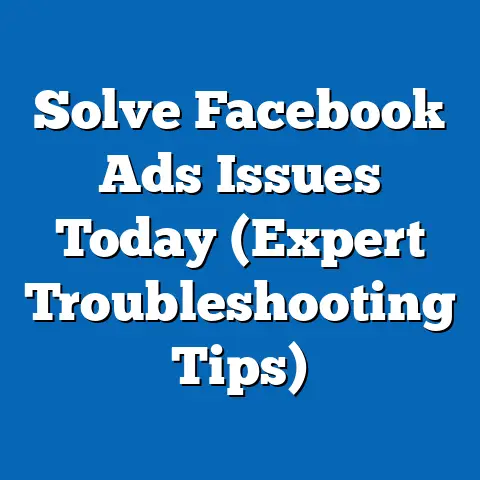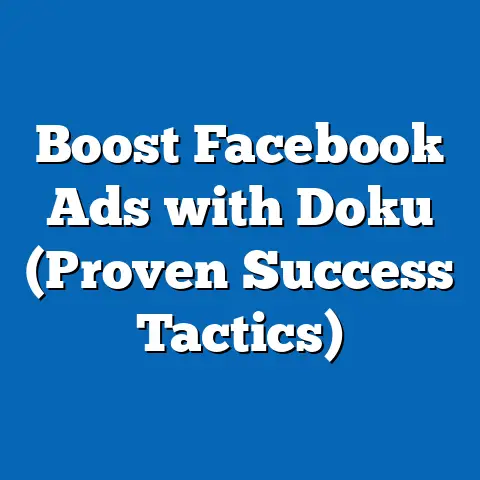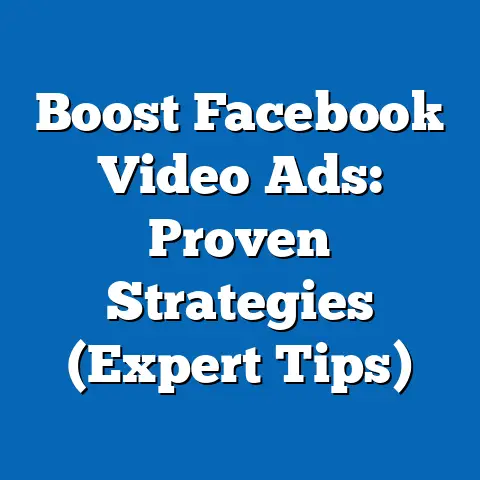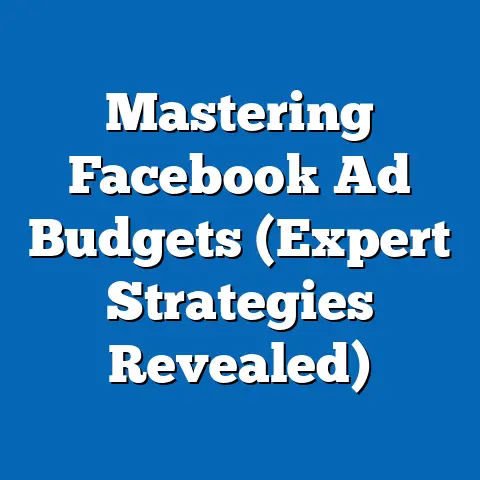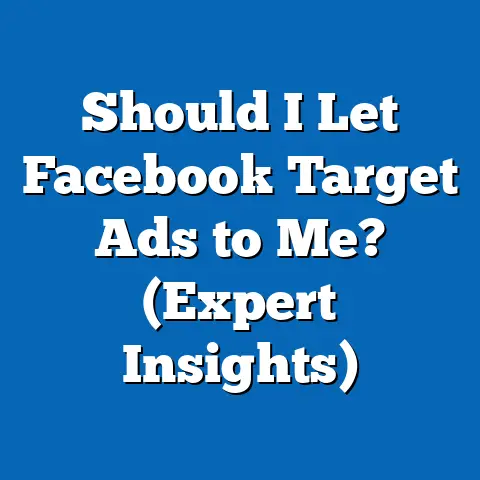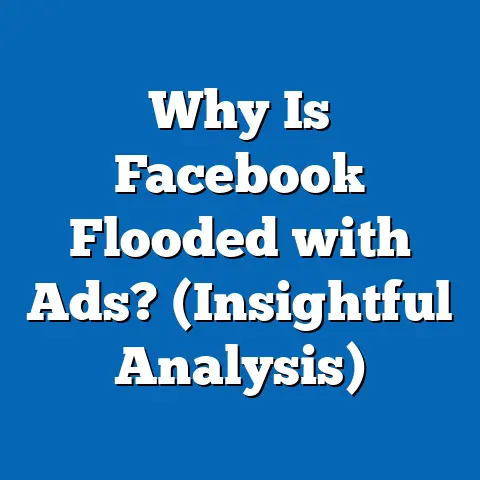Master Facebook Video Ads Sound (Boost Engagement Today)
The rain is drumming against my window as I write this. It’s a gray, somewhat dreary day, the kind where the world feels a little muted. But then, a flash of lightning illuminates the sky, followed by a booming clap of thunder – suddenly, the world is alive again! This, in a way, mirrors the world of digital marketing. Often, we focus so much on the visuals, the bright images, the catchy slogans, that we forget the power of sound. Just like that clap of thunder, sound can jolt our audience awake, grabbing their attention and leaving a lasting impression. And when it comes to Facebook video ads, neglecting sound is like ignoring half the potential impact. It’s time we give sound the attention it deserves!
Did you know that a significant portion of Facebook users watch videos with the sound off? Shocking, right? But that’s exactly why a well-crafted sound strategy is crucial. It’s about captivating the audience who do have their sound on and enticing those who don’t to turn it on. Let’s dive into how you can master the art of sound in Facebook video ads and significantly boost your engagement.
1: The Power of Sound in Video Advertising
Sound isn’t just a background element; it’s a powerful tool that can deeply affect how viewers perceive your message. Think about it: a suspenseful movie scene wouldn’t be nearly as effective without the ominous music, and a heartwarming commercial relies heavily on the emotional score to tug at your heartstrings. The same principles apply to Facebook video ads.
The Psychology of Sound
Sound has a profound psychological impact. Studies have shown that audio can influence:
- Mood: Upbeat music can create a positive association with your brand, while calming sounds can evoke trust and relaxation.
- Perception: Sound effects can make your product seem more powerful, elegant, or fun. The right audio can completely reshape how someone perceives your brand.
- Memory Retention: Catchy jingles or memorable voiceovers can help viewers remember your brand long after they’ve seen the ad. Think about those annoying-but-effective jingles that get stuck in your head – that’s the power of auditory branding at work!
Auditory Branding: Creating a Signature Sound
Auditory branding is the art of using sound to create a unique and recognizable identity for your brand. It’s about crafting a sonic logo, a jingle, or a specific soundscape that immediately identifies your brand to the listener.
For example, think of the Intel chime. It’s short, simple, and instantly recognizable. Or the distinct sound of a Harley-Davidson motorcycle. These sounds are so ingrained in our minds that they instantly evoke the brand.
When creating your auditory branding, consider:
- Your brand values: What emotions do you want to evoke?
- Your target audience: What kind of music or sounds do they enjoy?
- Consistency: Use your auditory branding consistently across all your marketing channels.
Real-World Examples: Sound and Engagement
Let’s look at some brands that have nailed the use of sound in their Facebook video ads:
- Apple: Apple often uses minimalist, atmospheric music in its product reveal videos. This creates a sense of elegance and sophistication, perfectly aligning with their brand image. The focus on sound design helps to create an immersive experience that highlights the sleek design and innovative features of their products.
- Nike: Nike uses high-energy music and impactful sound effects in its ads to inspire viewers to push their limits. The audio helps to create a sense of excitement and motivation, encouraging viewers to take action. Their ads often feature the sound of sneakers squeaking on the court or the rhythmic breathing of athletes, amplifying the sense of athleticism.
- Dove: Dove often uses gentle, acoustic music and warm voiceovers in its ads to promote self-esteem and body positivity. The audio helps to create a sense of intimacy and trust, resonating with viewers on an emotional level. Their sound strategy supports their message of authenticity and empowerment.
Key Takeaway: Sound is not an afterthought; it’s a crucial element of your video ad strategy. By understanding the psychology of sound and creating a strong auditory brand, you can significantly boost engagement and leave a lasting impression on your audience.
Next Step: Start brainstorming ideas for your auditory branding. What sounds represent your brand? How can you incorporate these sounds into your video ads?
2: Types of Sounds to Utilize in Facebook Video Ads
Now that we understand the power of sound, let’s explore the different types of sound elements you can use to enhance your Facebook video ads.
Background Music: Setting the Tone
Background music is the foundation of your soundscape. It sets the tone and creates the overall mood of your ad.
- Purpose: To evoke emotions, create atmosphere, and enhance the storytelling.
- Tips:
- Match the music to your brand and message: Upbeat music for energetic brands, calming music for relaxing products, etc.
- Consider the pace of your video: Use faster music for action-packed scenes and slower music for emotional moments.
- Avoid generic music: Invest in high-quality, royalty-free music that stands out.
- Ensure the music doesn’t overpower the other sound elements, such as voiceovers or sound effects.
- Match the music to your brand and message: Upbeat music for energetic brands, calming music for relaxing products, etc.
- Consider the pace of your video: Use faster music for action-packed scenes and slower music for emotional moments.
- Avoid generic music: Invest in high-quality, royalty-free music that stands out.
- Ensure the music doesn’t overpower the other sound elements, such as voiceovers or sound effects.
Sound Effects: Adding Realism and Impact
Sound effects are the little details that bring your video to life. They add realism and impact to your visuals.
- Purpose: To enhance the visuals, create a sense of immersion, and emphasize key moments.
- Tips:
- Use sound effects sparingly: Too many sound effects can be distracting.
- Choose high-quality sound effects: Avoid generic or cheesy sound effects.
- Sync sound effects with visuals: Make sure the sound effects match the actions on screen.
- Consider using foley sound effects: These are sounds created in a studio to match specific actions, adding a layer of realism.
- Use sound effects sparingly: Too many sound effects can be distracting.
- Choose high-quality sound effects: Avoid generic or cheesy sound effects.
- Sync sound effects with visuals: Make sure the sound effects match the actions on screen.
- Consider using foley sound effects: These are sounds created in a studio to match specific actions, adding a layer of realism.
Voiceovers: Conveying Your Message
Voiceovers are a powerful way to convey your message directly to your audience.
- Purpose: To explain your product, tell a story, or provide a call to action.
- Tips:
- Choose a voice that matches your brand: A friendly voice for approachable brands, a professional voice for serious brands, etc.
- Write a clear and concise script: Get straight to the point and avoid jargon.
- Use a professional voice actor: A skilled voice actor can bring your script to life.
- Ensure the voiceover is clear and easy to understand: Avoid background noise and use proper microphone techniques.
- Choose a voice that matches your brand: A friendly voice for approachable brands, a professional voice for serious brands, etc.
- Write a clear and concise script: Get straight to the point and avoid jargon.
- Use a professional voice actor: A skilled voice actor can bring your script to life.
- Ensure the voiceover is clear and easy to understand: Avoid background noise and use proper microphone techniques.
Silence: Creating Tension and Emphasis
Silence can be just as powerful as sound. It can create tension, emphasize key moments, and give viewers a chance to process what they’ve seen and heard.
- Purpose: To create dramatic effect, emphasize a point, or allow viewers to reflect.
- Tips:
- Use silence sparingly: Too much silence can be awkward.
- Place silence strategically: Before a big reveal, after an emotional moment, etc.
- Consider the length of the silence: A short pause can create anticipation, while a longer silence can create a sense of unease.
- Use silence sparingly: Too much silence can be awkward.
- Place silence strategically: Before a big reveal, after an emotional moment, etc.
- Consider the length of the silence: A short pause can create anticipation, while a longer silence can create a sense of unease.
The Importance of Sound Quality and Clarity
No matter what type of sound elements you use, it’s crucial to ensure that they are of high quality and clarity. Poor audio can detract from the overall viewer experience and make your ad seem unprofessional.
- Tips:
- Use a good microphone: A high-quality microphone is essential for recording clear audio.
- Record in a quiet environment: Avoid background noise and echoes.
- Use sound editing software: To clean up your audio, remove unwanted noise, and adjust the levels.
- Test your audio on different devices: To ensure it sounds good on phones, laptops, and speakers.
- Use a good microphone: A high-quality microphone is essential for recording clear audio.
- Record in a quiet environment: Avoid background noise and echoes.
- Use sound editing software: To clean up your audio, remove unwanted noise, and adjust the levels.
- Test your audio on different devices: To ensure it sounds good on phones, laptops, and speakers.
Key Takeaway: There are many different types of sound elements you can use to enhance your Facebook video ads. By carefully selecting and combining these elements, you can create an engaging soundscape that captivates your audience.
Next Step: Experiment with different types of sound elements in your video ads. See what works best for your brand and message.
3: Creating Engaging Soundscapes for Facebook Ads
Now that you know the different types of sounds you can use, let’s dive into the practical techniques for creating effective soundscapes for your Facebook ads.
Sound Editing and Mixing Basics
Sound editing and mixing are the processes of manipulating and combining different sound elements to create a cohesive soundscape. Here are some basic techniques:
- Cutting and Trimming: Removing unwanted sections of audio.
- Fading: Gradually increasing or decreasing the volume of a sound.
- Panning: Moving a sound from one speaker to another.
- Equalization (EQ): Adjusting the frequency balance of a sound.
- Compression: Reducing the dynamic range of a sound.
- Reverb: Adding a sense of space to a sound.
Don’t be intimidated by these technical terms! There are many user-friendly sound editing tools available that make these processes easy to learn.
Recommended Tools for Beginners
- Audacity (Free): A powerful and versatile open-source audio editor.
- GarageBand (Free for Mac users): A user-friendly audio editor with a wide range of features.
- Adobe Audition (Paid): A professional-grade audio editor with advanced features.
- Filmora (Paid): A video editor with built-in audio editing capabilities.
Step-by-Step Guide: Incorporating Sound into Your Facebook Video Ad
- Brainstorm Sound Ideas: Before you even start filming, think about the sound elements you want to include in your ad. What kind of music would best represent your brand? What sound effects would enhance the visuals? What message do you want to convey with your voiceover?
- Select Appropriate Audio Clips: Once you have a clear idea of the sound elements you want to use, start searching for appropriate audio clips. There are many websites that offer royalty-free music and sound effects, such as:
- Epidemic Sound
- Artlist
- AudioJungle
- FreeSound
- Record Your Voiceover: If you plan to use a voiceover, write a clear and concise script and record it using a good microphone in a quiet environment.
- Edit and Mix Your Audio: Use sound editing software to clean up your audio, remove unwanted noise, and adjust the levels.
- Sync Sound with Visuals: Import your audio into your video editing software and sync it with your visuals. Make sure the sound effects match the actions on screen and the music complements the overall tone of the video.
- Test and Iterate: Once you’ve finished editing your video, test it on different devices to ensure it sounds good on phones, laptops, and speakers. Get feedback from others and make revisions as needed.
- Epidemic Sound
- Artlist
- AudioJungle
- FreeSound
A/B Testing Sound Elements
A/B testing is a powerful way to optimize your soundscape. Try creating two versions of your ad with different sound elements and see which one performs better.
- Example: Test two different background music tracks to see which one resonates more with your target audience.
- Metrics: Track engagement rates, shares, and conversions to determine which version is more effective.
Key Takeaway: Creating an engaging soundscape for your Facebook video ads requires careful planning, skillful editing, and a willingness to experiment.
Next Step: Download a sound editing tool and start practicing your skills. Experiment with different sound elements and A/B test your ads to see what works best.
4: Case Studies of Successful Facebook Video Ads with Sound
Let’s analyze some specific Facebook video ads that have successfully utilized sound to boost engagement.
Case Study 1: Dollar Shave Club
Dollar Shave Club is known for its humorous and irreverent video ads. Their early viral video ad featured a catchy jingle, witty voiceover, and impactful sound effects.
- Metrics: The video generated over 12,000 orders within 48 hours and helped the company gain significant brand awareness.
- Analysis: The sound elements in this ad were perfectly aligned with the brand’s quirky personality. The jingle was memorable and catchy, the voiceover was humorous and engaging, and the sound effects added to the overall comedic effect.
- Lesson Learned: Don’t be afraid to be creative and unconventional with your sound elements. If it aligns with your brand and message, it can pay off big time.
Case Study 2: Old Spice
Old Spice’s “The Man Your Man Could Smell Like” campaign is another example of successful use of sound in video advertising. The ads featured a charismatic spokesman, a dramatic voiceover, and impactful sound effects.
- Metrics: The campaign generated over 100 million views on YouTube and helped Old Spice revitalize its brand image.
- Analysis: The sound elements in this ad were designed to be over-the-top and attention-grabbing. The dramatic voiceover and impactful sound effects created a sense of excitement and intrigue.
- Lesson Learned: Use sound to create a sense of drama and excitement. If you can capture your audience’s attention, they’re more likely to engage with your ad.
Case Study 3: Airbnb
Airbnb often uses calming music and warm voiceovers in its video ads to promote the feeling of belonging and connection.
- Metrics: Airbnb’s video ads have generated millions of views and helped the company build a strong brand reputation.
- Analysis: The sound elements in these ads are designed to create a sense of intimacy and trust. The calming music and warm voiceovers evoke feelings of relaxation and comfort.
- Lesson Learned: Use sound to create a sense of intimacy and trust. If you can connect with your audience on an emotional level, they’re more likely to choose your brand.
Key Takeaway: By analyzing successful Facebook video ads, you can learn valuable lessons about how to use sound to boost engagement.
Next Step: Analyze your own Facebook video ads and identify areas where you can improve your sound strategy.
5: The Future of Sound in Facebook Advertising
The world of sound is constantly evolving, and there are many emerging trends that marketers should be aware of.
The Rise of ASMR
ASMR (Autonomous Sensory Meridian Response) is a tingling sensation that some people experience in response to certain sounds and visuals. ASMR has become increasingly popular in recent years, and some brands are starting to experiment with ASMR in their marketing campaigns.
- Example: A skincare brand might create a video ad featuring the gentle sounds of applying lotion to the skin.
- Potential Benefits: ASMR can create a sense of relaxation and intimacy, which can be appealing to some viewers.
Interactive Sound Features
Facebook is constantly adding new features to its platform, and it’s possible that interactive sound features could become more prevalent in the future.
- Example: Viewers might be able to choose different background music tracks for a video ad.
- Potential Benefits: Interactive sound features can increase engagement and allow viewers to personalize their experience.
AI in Sound Design
Artificial intelligence is also playing a role in the future of sound design. AI-powered tools can help marketers create custom music tracks, generate sound effects, and even analyze the emotional impact of different sounds.
- Example: A marketer could use an AI tool to create a custom music track that perfectly matches the tone and message of their video ad.
- Potential Benefits: AI can help marketers create more effective and engaging soundscapes.
Key Takeaway: The future of sound in Facebook advertising is bright. By staying ahead of the curve and experimenting with new technologies and trends, you can create truly innovative and engaging soundscapes.
Next Step: Research emerging trends in sound and start experimenting with them in your Facebook video ads.
Conclusion: Embracing Sound for Enhanced Engagement
Just as the weather can change our mood and perception of a day, the right sound can transform a video ad into an engaging experience that resonates with viewers. By mastering the art of sound in Facebook video ads, you can significantly boost engagement, leave a lasting impression, and ultimately drive better results for your business.
Don’t underestimate the power of sound. It’s not just a background element; it’s a crucial tool that can make or break your video ad. Embrace sound as an essential tool in your advertising arsenal and start creating compelling and memorable content today!
Call to Action: Start incorporating sound into your Facebook video ads immediately! Share your experiences and outcomes with your audience, sparking a conversation about the evolving role of audio in digital marketing. Let’s create a world where sound is no longer an afterthought, but a strategic element that enhances the power of video advertising.

